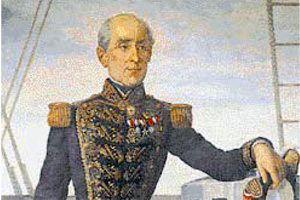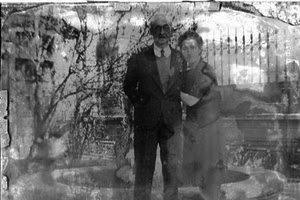The first objective of Prieto was to restore the order in the country. For that purpose, he designated Joaquin Tocornal as the Minister of the Interior and he ordered him to put an end to the attacks of the bandits who were desolating the pre-mountain zone of Chillan, headed by Antonio Pincheira. Later, and also with the objective of maintain the public order, officers and soldiers who did not show a clear allegiance to the government were discharged.
In the economic sector, the Minister of Finance, Manuel Rengifo, adopted important actions towards the reactivation of the economy. Some of them were: the deleting of the taxes which taxed almost of all the agricultural and industrial production (which raised the price of the products), the reopening of the depot warehouses in Valparaiso (favoring the external trade), the elimination of the transit rights (customs payment to drive) and other taxes.
In this context, a new Customs law was also enacted that year, which stimulated the scientific, cultural and technological work of the country, because it freed the payment of the Internment rights of all the elements that would contribute to the national progress, such as machineries, mechanical instrumentation, books and printing articles.
New customs duties were also established for importing and exporting, and the National Agricultural Society (1838) was founded.
On the other hand, upon the discovering of the silver mine of Chañarcillo, in 1832, the government debt was alleviated and the construction of urban buildings was boosted.
In education, the internal plant and organization of the National Institute was completely modified, hiring foreigners such as Claudio Gay and Andres Bello. In 1833, the first Medicine and Pharmaceutical schools were founded and later, the following year, the school of Obstetrics.
In health matters, the charitable and public health boards were created, where Lorenzo Sazie and Guillermo Blest worked.
Constitution of 1833
Promulgated on May 25th of 1833, it was one of the main achievements of the government of Prieto, because it settled the political bases through which Chile was governed for almost 100 years. For this purpose, the Congress chose a “Great Convention” formed by 17 deputies and a twentieth of the citizens of recognized honorability.
The Convention named the commission who had the responsibility of drafting the project, which was integrated by seven members, among them were Mariano Egaña and Manuel Jose Gandarillas, the first one with an authoritarian tendency and the second one with liberal tendencies.
This Constitution established the independence between the Executive and the Legislative. The first one could name and remove his ministers, and the second one, could accuse and censor them. In addition to vito (veto) the budget and contributions acts and authorizing the Executive the use of extraordinary facilities in the event of war or internal disturbance, it could decree state of siege in one or many places of the country, in accordance to the Council of State. The Congress was composed by two chambers, the Deputies and the Senate.
The president of the Republic lasted 5 years in charge and could be reelected one more time for the same period of time. If none of the candidates had the absolute majority, the Congress had to choose the new ruler through a secret voting between the 2 people with the greater number of votes. The catholic, apostolic and roman religion was set as the official religion of the Republic, with the exclusion of the public practicing of any other.
It was established that the State was conformed by the ministers, two members of the courts of justice, a clergyman, a general of the army, a chief of the Finance office, two people who had already been ministers of the State and two individual people who also had already occupied the position of intendant, governor or mayor. Such members studied the projects that the Executive was sending to Congress, they formed the group of three to provide the positions of judges and court ministers, and solved the lawsuits in which the treasury was a part of, among other things.
In addition, it was defined that the Chilean territory was divided in provinces, departments, sub-branches and districts, govern by intendants, governors and inspectors. In each department there was a municipality composed by majors and rulers.
War against the Peru-Bolivian Confederation (1836-1839)
As the new constitution allowed it, Jose Joaquin was reelected for a new term, between 1836 and 1841. This period was marked by the war against the Peru-Bolivian Confederation, which was extended until 1839.
During almost a decade, Chile and Peru had various conflicts that ended in an armed confrontation. Some of the antecedents that determined the beginning of the war were the following:
– Peru owed Chile a million and a half pesos (plus the interests) who had given the loan requested by Antonio Jose de Irisarri in the times of the Independence. Peru also owed the expenses originated by the Liberator Expedition.
– Since 1824, the Peruvian government had increased the custom taxes to the Chilean agricultural products such as wheat. Chile, on the other hand, did the same thing with Peruvian sugar.
At the same time, with the depot warehouses, Valparaiso had become into the commercial center of the Pacific. Peru wanted to reverse this situation thus favoring its port, Callao, reason why it added additional taxes to the merchandise coming from Valparaiso.
– In 1825 the Republic of Bolivia was created, independent from Argentina and Peru, to whom had belonged before the independence. The Bolivian president Andres de Santa Cruz wanted to reunite his country with Peru. Thus, and taking advantage of the internal anarchy of Peru, he gained followers and ended up defeating Felipe Santiago Salaverry and Agustin Gamarra, which facilitated his plans.
In this way, he achieved to proclaim the union of both nations in the Peru-Bolivian Confederation, in which he proclaimed himself as its Great Protector.
After achieving this objective, he convinced Ramon Friere (who at the time was exiled in Peru after Lircay) to organize a squadron to attack Chile, but this attempt failed.
Portales took on the offensive and ordered Victorino Garrido to execute an attack against the Peruvian squadron hiding in el Callao.
Despite its inferiority, the Chilean fleet achieved the capturing of the majority of the Peruvian ships. Upon this situation, the Confederation asked for a truce and tried to pacifically negotiate, but the Chilean government refused to do it and sent Mariano Egaña to demand from Santa Cruz the payment of the pending debt and also to dissolve the Confederation.
As he refused to do so, Egaña declared the war on December 28th of 1836.
In Chile, the government established state of siege and Congress gave extraordinary powers to the Executive. The opposition accused Portales of authoritarianism, at the time that he was unfolding and intense campaign on the press against him and the unpopular war.
Assassination of Portales
The war situation that was happening in that moment obligated the government of Prieto to take on drastic actions, such as declaring state of siege and obtaining extraordinary powers form Congress.
In addition, the agents of Santa Cruz, colluded with the exalted pipiolos and with the discharged soldiers, who were conspiring against the government, especially, against Portales, were making propaganda against the war, presenting it as an excuse of the authoritarianism of the minister. Moreover, there were opposers to the war inside the very same army.
Thus, when Portales was passing a military review of a troop detachment quartered in Quillota, under the command of Jose Antonio Vidaurre, he was surrounded and arrested (June 3rd of 1837). In the following day, Vidarrue ordered the transfer of Portales to Valparaiso, but the party did not arrive, because the Valdivia battalion and the civic guards of the port – the same ones that Portales had formed while he was the intendant of that city – cut their path on the Baron hill.
The minister was being watched over by a convoy directed by the captain Santiago Florin, who ordered his shooting 2 days later, on June 6th.
Blanco Encalada and Bulnes in the war
The first war action against the Peru-Bolivian Confederation was under the command of the admiral Manuel Blanco Encalada. He arrived to Arequipa, but when he realized that he was the minority, he could not do anything else but to celebrate a treaty of peace, which was signed in Paucarpata (November 17th of 1837). In this treaty, the devolution of the captured ships was established, as well as the reestablishment of the commercial relationships, the withdrawal of the Chilean army, and the Peruvian recognition of the claimed debt.
However, the Chilean government rejected this treaty and drafted a decree in which it was stipulated its disapproval and that the war had to continue.
In 1838, Manuel Bulnes, in command of an army of 6,000 men, resumed the fight. Thus, on August 21st of 1838 the combat of Portada de Guias took place, which allowed the Chilean occupation of Lima. Later, the combat of Puente de Buin and the naval de Casma came to pass (January 6th and 12th of 1839), where the troops and the squadron of the Confederation were defeated one more time.
On January 20th of 1839, Bulnes attacked again the army of Santa Cruz near the Peruvian town named Yungay. The combat tsarted on th hill Punyen and later continued on the hill Pan de Azucar, where the restorers (Chilean troops) defeated the forces of the Confedrate army, a triumph which implicated the disintegration of the Confederation.
Upon his return to Chile, Bulnes was received with great hubbub and was named state counselor by president Prieto. This designation was the previous step before launching his presidential candidature.








